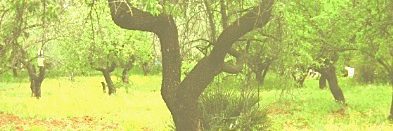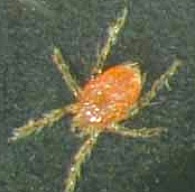Or bites rather, and such itchy ones too, from the grass mites (Grasmilben), the one thing I shall not miss at all when I leave my garden in Bonn. These are microscopic insects that live in the grass and the soil, and latch onto warm-bodied passersby – dogs, cats, most likely moles and voles and birds as well, and of course gardeners. And since I don’t have any pets at the moment, and I’m the only gardener around, guess who gets the mites’ undivided attention?
Grass mites, Neotrombicula autumnalis, are also known as harvest mites, berry mites, or hay mites, being most prevalent from late summer to early autumn – harvest time, when the blackberries are ripening in the hedgerows and when farmers are busy harvesting crops and making hay.
Normally I make sure to rub my ankles, wrists, and other exposed body parts with a plant-based preparation before venturing out into the garden. Somehow with the colder temperatures brought on by the rains, I had assumed, ill-advisedly, that these soil denizens would have gone into hibernation. No such luck, and I have several parting gifts from them – hives and welts about 2 cm long. Terribly itchy, and likely to continue being so for the next 10 to 14 days. Hot showers and rubbing alcohol seem to allay the itching, but only somewhat. Vinegar has also been suggested, but that I have yet to try. I have heard of other people in Bonn who have it even worse – the bites balloon into golf-ball size or even larger! The best thing is not to scratch, as then infection or dermatitis is bound to set in.
What has puzzled me about grass mites, and none of the sites I’ve checked online has enlightened me, is: what happens to them when they drop off indoors after feeding on a host?
Apparently it is the larval stage of the grass mite that sticks its fangs into a soft, moist, thin-skinned part of its host, usually a hair follicle, to create a feeding tube (stylostome), rather like a drinking straw through which it sucks up liquefied skin cells. Ew.
The larval grass mite has enzymes that turn its host’s skin cells into its favourite liquid protein drink. It’s the enzymes that cause the itching.
Once it’s had its fill, it falls off. And this is where the details become rather scant. My online sources (including a dissertation from Bonn University by A. Schöler, 2003) say the larva, after falling off its host, then burrows underground, i.e., into the soil, to undergo two more intermediate changes as a nymph before morphing into adulthood.
What if, as is usually the case, they fall off indoors, in a house? Especially one with wooden floors? Can they find a welcoming niche in the warm interstices in the flooring? And although most of the literature note that these Neotrombicula mites themselves are not vectors for known illnesses, unlike the Japanese tsutsugamushi, which carries Rickettsia bacteria, I have to wonder why I have been so often ill with flu-like symptoms extended over many weeks since living in this house. I used to consider myself fairly robust and not prone to getting the flu, leastwise not every year.
So yes, I am happily bidding farewell to these tiny creatures, no doubt they too have a role to play in the greater design of the world and life. And I bid the moles and the voles goodbye as well, who’ve created so many tunnels under the lawn with exits popping up here and there, hidden by the grass, making the ground beneath take on a rolling, undulating aspect. And if you’re not careful walking, you are likely to twist an ankle if you chance to sink a foot into one of these portals.
I can only hope this is my last encounter with the Neotrombicula autumnalis or any of its kin. In North America, they are better known as chiggers. Though, as a keen gardener, perhaps not. I shall just have to experiment with rosemary and other herbs, steeped in vodka, to make my own grass mite repellent. I don’t fancy using DEET.

